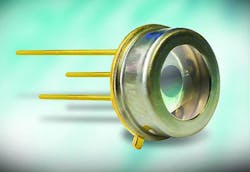Photodiode for stability after extreme ultraviolet conditions introduced by Opto Diode
The electro-optical device is housed in a TO-39, 3-pin, windowless package that delivers responsivity down to 1 nanometer. The active area is typically 2.5-millimeter and has a minimum shunt resistance (Rsh) of 20 MOhms at plus-or-minus 10 mV (typical).
The photodiode is suited forhigh power laser monitoring at wavelengths 1nm -- 200nm, or other tasks that require a stable photodiode after EUV exposure.
The device parameters include reverse breakdown voltage of 20 Volts, with the capacitance of 1 nanofarads (nF). The response time is 1 nanosecond (typical) to a maximum of 2 nanoseconds.
Storage and operating temperatures range from -10 degrees 40 Celsius, and from -20 to 80 C in nitrogen or vacuum conditions. The lead soldering temperature (0.08 inches from the case for 10 seconds) is 260 C; the maximum junction temperature is 70 C.
For more information contact Opto Diode online at http://optodiode.com.
